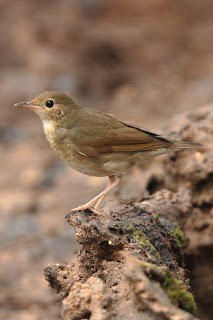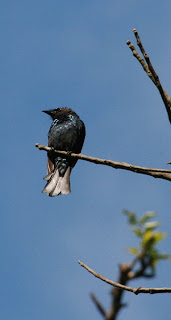Black Drongo
The Black Drongo Dicrurus macrocercus is a
medium sized passerine of temperate and tropical Asia. They are aggressive and
fearless slender birds, 28 cm in length, and will attack much larger species if
their nest or young are threatened. This behaviour led to the former name of
King Crow. They fly with strong flaps of the wing and are capable of fast
manoeuvres to capture insect prey. The Black Drongo has short legs and sits
very upright on perches or electricity wires like swallows. They may also perch
on grazing animals. Sighted in a threesome on a tree fringing the padi field in
Alor Setar.
These drongos feed predominantly on insects such as grasshoppers, cicadas,
wasps, bees and dragonflies. They often associate with Common Mynas, Cattle
Egrets and other birds that share a similar diet. Drongos benefit from the
association with more successful foraging. There is only partial overlap in the
insect prey sought by mynas and drongos. There are however cases of Drongos
preying on small birds. They have also been on occasion seen feeding on dead fish.
Flowers of trees such as Erythrina and Bombax may be visited for water and
nectar and they are sometimes known to feed on grains.They are only rarely
known to take larger arthropods such as scorpions and centipedes.
They often feed on insects late in the evening under electric lights and often
forage at night as well as anting.
As they are winter visitors they do not breed here. It breeds in south-east
Iran, Afghanistan, India, south-east Tibet, and from northern China
discontinuously south through south-west Thailand, to Bali and Java. Northern
populations migrate, wintering at lower altitudes and latitudes, reaching as
far south as central India in the west, and Malaysia and Sumatra in the east,
where they occur in tropical savanna, grassland and agricultural areas
(Jeyarajasingham and Pearson 1999). The nesting of the Black Drongo is mainly
from April to August. The usual clutch is four eggs laid in a cup nest placed
in the fork of a outer branch of tree. Their habit of driving away predators
from near their nests is believed to encourage other small birds to nest in the
vicinity.Cases of brood parasitism by the Asian Koel have been noted. An
intriguing case of a Red-vented Bulbul feeding Black Drongo chicks at their
nest has been noted



















































